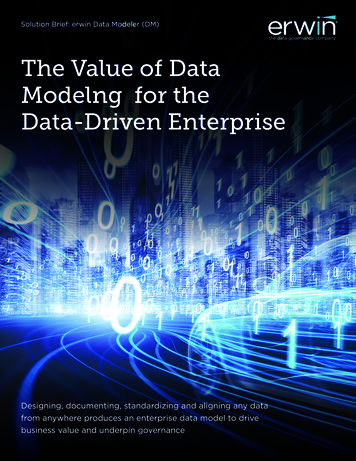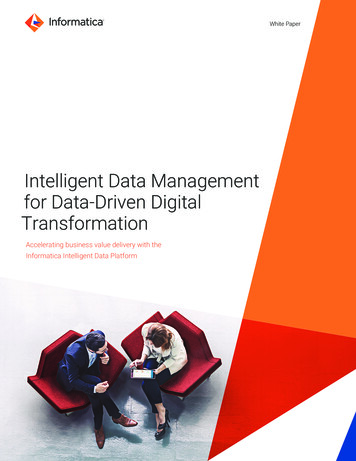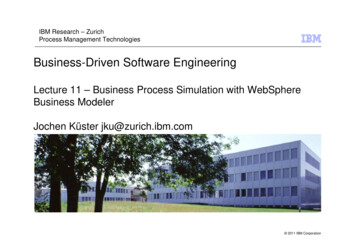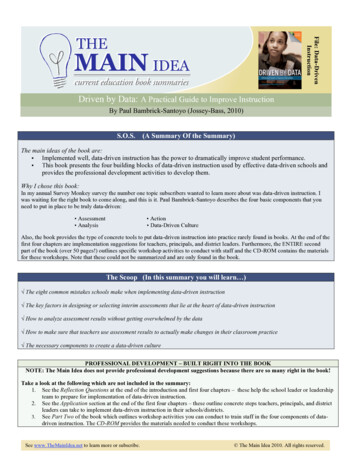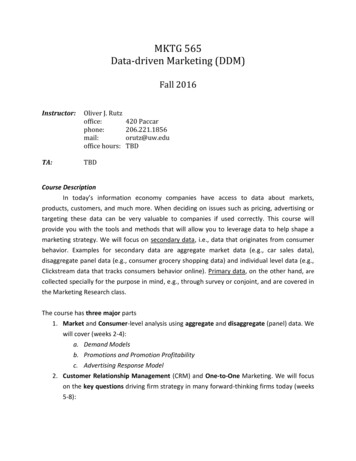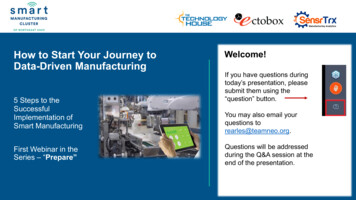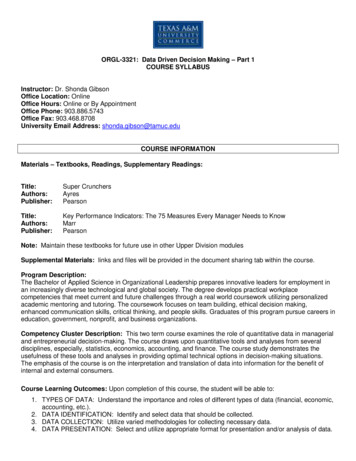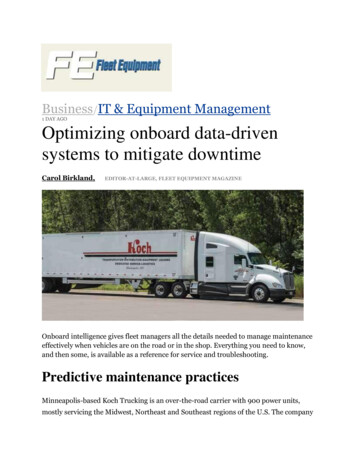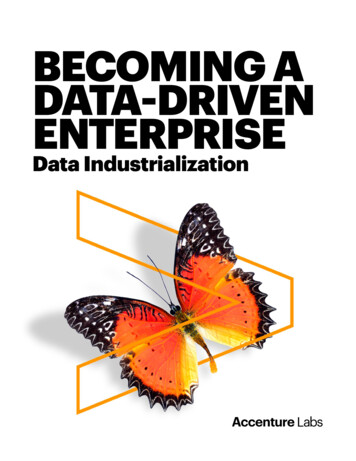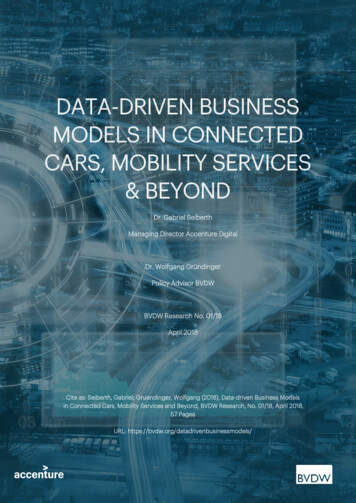
Transcription
DATA-DRIVEN BUSINESSMODELS IN CONNECTEDCARS, MOBILITY SERVICES& BEYONDDr. Gabriel SeiberthManaging Director Accenture DigitalDr. Wolfgang GründingerPolicy Advisor BVDWBVDW Research No. 01/18April 2018Cite as: Seiberth, Gabriel; Gruendinger, Wolfgang (2018), Data-driven Business Modelsin Connected Cars, Mobility Services and Beyond, BVDW Research, No. 01/18, April 2018,57 PagesURL: https://bvdw.org/datadrivenbusinessmodels/i
Executive SummarySeven in ten of the world’s most valuable brands are digital platforms with data-drivenbusiness models. While this new phenomenon is transforming the global economy,there is currently little academic research on the subject. To contribute to this nascentfield, this study develops a definition of data-driven business models and suggest a firstbusiness taxonomy.Interestingly, the world-leading internet platform players are currently all pushing intothe automotive and mobility area rendering it a key battle ground for new data-drivenbusiness models in the dawning Internet of Things era. While tech players are investingbillions in respective offerings (keyword: autonomous driving, connected mobility),OEMs are under pressure to develop their own data-driven value propositions. This racefor the customer interface and successful data-monetization models makes automotivethe perfect object of investigation.The goal of this report is to examine the state of data-driven business models within theautomotive industry and to provide an overview of future trends. To quantify the dataopportunity for automotive, a forecast of the growth trajectory until 2050 is derived –based on a framework with three distinct business models including subsequent servicedomains and use cases.The findings of this study suggest that OEMs are already active players in an increasinglydata-driven environment. To become complete digital protagonists, they need toleverage digital ecosystems and enforce cooperation. Furthermore, OEMs must learnhow to capitalize on their strong brand reputation within the digital service domain. Theassessment also reveals important clues for strategic positioning: car makers should notseek to copy Uber or Google. On contrary. They possess a capability typical internetcompanies are now seeking to acquire: hardware manufacturing. In the cyber-physicalworld of the Internet of Things, physical strikes back. Whoever controls the completechain – hardware, data, insights and digital services – can deliver the most superior brandexperience.Still, OEMs are currently overly product centric; to fully influence data-driven businessopportunities, they need to open their activities beyond the car. Successful data-drivencompanies do not keep themselves restricted to only one area of activity; rather theyknow how to build a comprehensive ecosystem encompassing virtually all areas of life.ii
ContentsTable of Figures . iv1 Context and Scope . 51.1 Defining data-driven business models . 51.2 Data-driven business models in Practice . 91.3 Data-driven business models in the Automotive Industry . 112 Digital Ecosystems as Market Opportunity for OEMs . 143 Quantifying the Data Opportunity in Automotive . 173.1 Development of Automotive Profit Pools .174 Data-driven business model Framework . 194.1 Framework Overview . 194.2 Business Typology . 194.3 Deriving Generic Business Models . 214.3.1 Data Harvesting . 214.3.2 Data Matching . 224.3.3 As-a-Service .235 Service Domains . 255.1 Domains Definition and Use Cases .255.2. Service Revenues and Growth Trajectory . 275.3. Service Positioning – Between Monetization and Brand Impact . 276 Status Quo of data-driven business models in Automotive . 306.1 Study Design . 306.2 Foundation of data-driven business models . 316.2.1 Prerequisites for data-driven business models. 316.2.2 Emerging Technologies . 316.3 Current Applications of data-driven business models in Automotive. 336.3.1 Maturity Model . 336.3.2 Industry Convergence and The Car in the Internet of Things . 367 How to Master the Next 30 Years Ahead. 418 Conclusion . 44References . iiiiii
Table of FiguresFigure 1: R&D spends driven by AI . 9Figure 2: Market capitalization . 10Figure 3: The world’s most valuable companies are data-driven . 10Figure 4: Tech companies are claiming the customer interface in the car. 12Figure 5: The value network of the connected mobility sector . 14Figure 6: The Apple example: combine premium product with superior ecosystem . 15Figure 7: The OEM sweet spot. 16Figure 8: The value network of the connected mobility sector .17Figure 9: Three basic types of data-driven business models OEMs can apply. 19Figure 10: Advanced Driver Assistance Systems in the Connected Car . 22Figure 11: Example services assigned to the different data business models . 26Figure 12: Revenue Potential of the different service domains. 27Figure 13: Service domains of OEMs. 29Figure 14: Interview partners of this study . 30Figure 15: Findings in terms of customer and technology readiness . 31Figure 16: The model of concentric business model innovation . 34Figure 17: Converging areas of the Internet of Things . 38Figure 18: Recommendations derived from the study . 41iv
1 Context and Scope1.1 Defining data-driven business modelsData-related business models are entering the CEO agenda. Fueled by anunprecedented availability of data, business strategies are increasingly grounded onanalytics. In the light of an accelerating big data explosion, this development is about toreach the next level: data do not only enable strategies, they become the strategy(Redman, 2015; Schrage, 2016). In other words: a growing number of organizations usesdata not only to improve existing processes and functions, but to enable entirely newbusiness models.A business model defines the product a company provides and the way it interacts withcustomers and suppliers (Ovans, 2015). It relies on few key founding pillars: A superiorvalue proposition, a profit formula that outlines how to convert value into revenue andthe key resources and processes to deliver the proposition (Johnson, Christensen, &Kagermann, 2008). These key resources are among others brand, people, technology,partnerships and data. Data as a key resource for a firm’s value proposition – and thusfor its business model – is a very new field of research.Of course, data can contribute in separate ways to a value proposition. Essentially, thereare two main directions: data can add value to a key resource or they can form the keyresource itself. Organizations doing the latter – i.e. using data as their primary keyresource – are often startup companies without existing processes. They start fromscratch and put data in the center of their strategy. This is easier for startups as they donot have the legacy or “organizational debt” (Dignan, 2016) of established companies –a situation often referred to as the “innovators dilemma” (Christensen, 2013). However,existing companies, not uncommonly large corporations, experiment with data as a keyresource as well – an emerging field of activity and the core area of interest for this study.If large corporations pivot to data-driven value propositions and smart services, with selflearning, prediction, personalization, language processing for example, they need tobreak up existing silos to fully leverage data towards the customer (Kagermann &Riemensperger, 2015). This would demand a different organizational approach. Dataexperts like Andrew Ng, former Chief Scientist of Baidu and Google, recommend suchcorporations to hire a Chief AI Officer into their C-Suite to adequately represent datamatters within the board and within corporate strategy. The idea is: if data contribute tothe core value proposition, they cannot be treated on a divisional level (Ng, 2016). Asector perspective on data might be sufficient, if data are used to automate existingprocesses and improve productivity – which will probably be true for the majority ofbusinesses (Hammond, 2017). In cases of a data-driven Business Model transformation,data matters need representation at the board-level to avoid the traps and pitfalls of theinnovators dilemma.Besides organizational considerations, business transformation requires a clear strategicroadmap. Strategy entails a distinctive concept that can be put into operation. Here is anotable gap, astoundingly, data-driven business models are not well researched.Namely, there is no canonic or elaborated definition in place. The only common ground5
seems to be the notion that data-driven business models leverage data as a key resource(Hartmann, Zaki, Feldmann, & Neely, 2014). This bears an important reference toresource theory, but has limited explanatory value (Barney, 1991; Barney, 2001; Lockett,Thompson, & Morgenstern, 2009). It is unclear how data function as a business resourceand what their properties are compared to other resources. The typical requirementstowards a resource – to be valuable, rare, imperfectly imitable and non-substitutable arenot equally relevant for data in all cases, for instance if open and crowd-sourcedinformation is concerned. Scholars, analysts and strategists only recently begun toquestion what this evolving market will look like and how to classify the emergingbusiness models (Hartmann, Zaki, Feldmann, & Neely, 2014). Additionally, it will beimportant for organization to understand what kind of dynamic capabilities are neededto build and sustain data expertise within rapidly changing business conditions (Teece,Pisano, & Shuen, 1997).This study aims to contribute to the data-driven strategy agenda by evaluating datadriven business models based on the example of a data-intensive lead industry. Thestarting point is the basic classification that refers to data as a key resource which isfurther developed by applying additional defining characteristics.Data are valuable if they are used to apply a novel dimension to a prevailing businesspractice or enable new business types sui generis. The value dimensions can besummarized as product or service (what is offered?), business processes (how is itoffered?) and business model (how is it monetized?). Business transformation usuallyentails all dimensions,
Data as a key resource for a firm’s value proposition – and thus for its business model – is a very new field of research. Of course, data can contribute in separate ways to a value proposition. Essentially, there are two main directions: data can add value to a key resource or they can form the key resource itself.File Size: 2MBPage Count: 57
